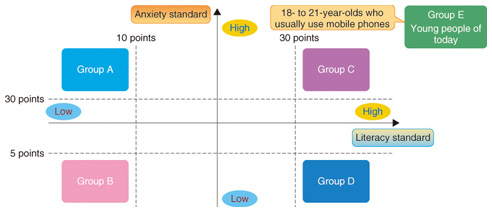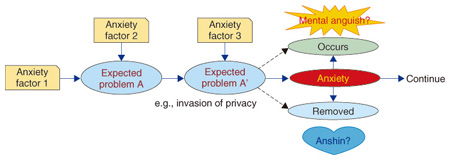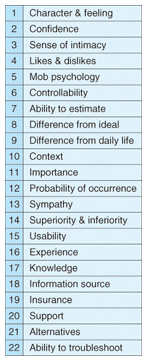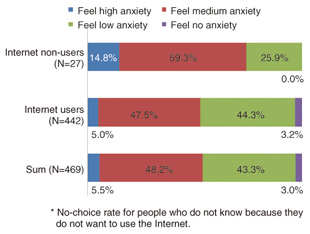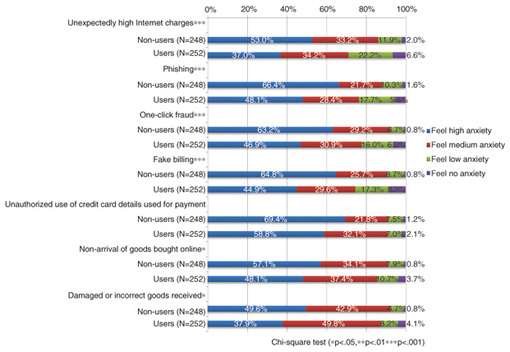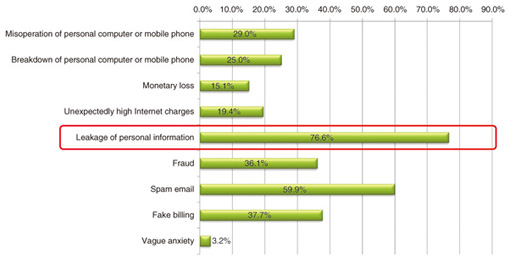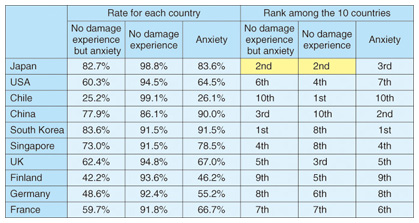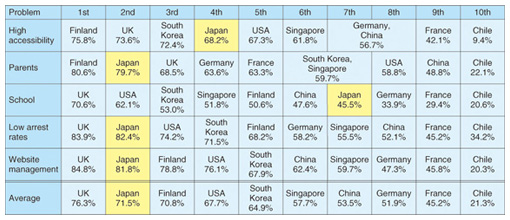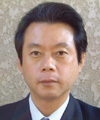 |
|||||||||||||
|
|
|||||||||||||
|
Feature Articles: Collaborations with Universities Leading to Open Innovation in NTT's R&D Vol. 9, No. 10, pp. 50–57, Oct. 2011. https://doi.org/10.53829/ntr201110fa8 Joint Research on Anshin in Internet UsageAbstractNTT Information Sharing Platform Laboratories is conducting joint research with specialists in socio-psychology at the University of Tokyo and Toyo University to study anshin
1. IntroductionAnshin Because we believe that it is possible to share, at least partially, the objective and universal concept of anshin, we began studying anshin, especially with regard to Internet usage. The Internet has become a social infrastructure and demand for its availability by both end users and suppliers is very high. We think that trying to study anshin using only an approach based on information technology (IT) is inadequate, so we also applied a social-science approach. NTT began a collaborative study with the University of Tokyo, which was later joined by Toyo University. The NTT team members are IT engineers and the University members are social scientists. Since the start of the project, the number of people in the research team has grown, enabling us to conduct social research from a wider range of viewpoints. In this article, we describe our studies and present the results. On the basis of the results of group interviews with 23 people in Tokyo on anshin and anxiety, we conducted a home-visit investigation with 500 people in Tokyo and an international telephone investigation of 3300 people in ten countries (330 in each country). In this article, we do not define anshin precisely or use an English translation because it is so vague. On the other hand, fuan 2. Group interviewsBefore investigating negative factors of anshin and the correlation among them, we conducted group interviews about anshin and anxiety to help us design appropriate questionnaires for use in the following investigations. The interviews took place on September 17–19, 2008 (Wednesday–Friday) in Tokyo, Japan. There were 23 people in five groups (A–E). The characteristics of these groups in terms of anxiety and literacy are shown in Fig. 1. Each session lasted two hours. The questions asked about cases in which the participants felt anshin or anxiety in their daily lives and while using the Internet.
From these group interviews, we found that it is not easy to obtain clear, adequate, and quick answers to questions about cases of anshin. By contrast, relatively clear and quick answers tended to be obtained to questions about cases of anxiety. Moreover, anshin varied from person to person. So, as our first step, we decided not to study anshin directly but to study anxieties. We believe that anxiety is a close antonym of anshin and that anxiety is easier to handle. 3. Anxiety generation process3.1 ModelTo study anxiety, we used the results of the group interviews to construct a model of the anxiety generation process in order to clarify how anxiety is generated (Fig. 2). This model includes the following definitions: 1) Anxiety is generated by expectations of problems (e.g., invasion of privacy). 2) There are factors that are the reasons for expecting problems and there are also factors that strengthen the expectations and anxieties. 3) There are also factors that weaken or eliminate the expectations and anxieties. We called these factors anxiety factors. In future, we intend to refine and verify this model and also evaluate the anxiety factor candidates.
3.2 Control of Internet anxietyWe think that controlling (reducing) anxiety can weaken the feeling of expecting trouble and leads to a kind of anshin. We also think that the anxiety factors are determined by each type of expected trouble for each Internet service. We selected anxiety factor candidates mainly on the basis of the group interview results. They are listed in Table 1. We hope that establishing a method of controlling anxiety will lead to anshin.
4. Home-visit investigation in TokyoNext, partially to verify the anxiety generation process model and to obtain facts about anxiety from various viewpoints, we conducted a home-visit investigation of Internet anxiety [2]. The investigation took place in February 2009 in Tokyo. It involved 500 people (aged from 15 to 69). The visited homes were chosen by random area quota sampling. The questions concerned anxiety when using the Internet. 4.1 Internet users and anxietyWe found that Internet users felt less anxiety about Internet usage than non-users did (Fig. 3). The more time they spent using the Internet, the less anxiety they felt concerning security and Internet communication. People who wrote things and posted them on the Internet (consumer generated media (CGM*) users) felt less anxiety in their general Internet usage than people who only read content on the Internet. The more frequently people commented on SNSs, the less anxiety they felt about Internet communication. These findings may indicate that anxiety decreases with experience.
4.2 Usability and content of anxietyMany people use online shopping despite having strong feelings of anxiety (Fig. 4). This may indicate that there is a trade-off between anxiety and usability. The most common specific anxiety for general Internet use was the leakage of personal information (Fig. 5).
4.3 Damage experience and news experienceThe amount of damage actually experienced by people is generally small. Even for spam emails and spam in blogs (also called blog spam or comment spam), which account for the highest percentage of anxieties in Fig. 5, only 12.0% of the subjects we questioned reported experiencing actual damage from them. Although the values are really too small to let us evaluate the correlation with anxiety, we nevertheless tried to evaluate the correlation, but we were unable to find any significant correlation (the only exception was unexpectedly high Internet charges). By contrast, damage is extensively reported by the news media. Our analysis of the results of the influence of news reports indicates that the more time people spend consuming mass media news, especially newspapers, the more anxiety they feel about security and Internet communication. 5. International investigation by telephoneDespite obtaining the abovementioned findings about Internet anxiety, we did not know whether they represent universal characteristics or local peculiarities. Unlike anshin, which is an obscure concept and hard to translate, fuan can be translated from Japanese into English, so anxiety is a universal concept. Therefore, we thought that an international comparison of Internet anxieties would be possible. To study anxiety in Japan and also to study anshin indirectly, we conducted an international investigation of ten countries by telephone [3]. The interviews took place in January and February 2010. We interviewed 3300 people (aged from 15 to 69) in the largest cities in Japan, China, South Korea, Singapore, the UK, Germany, France, Finland, America, and Chile (330 in each). They were contacted by random digit dialing. The questions concerned Internet anxiety. 5.1 Unbridgeable gulf between anshin and safetyWe publicly disclosed our findings in an NTT press release in September 2010 [4]. It stated that Japanese people feel high anxiety about using the Internet although they have less direct experience of trouble than people in other countries. We showed, by using real data, that there is an unbridgeable gulf between anshin and safety. These results (Table 2) show that there are a lot of Japanese who cannot use the Internet with anshin only owing to safety concerns. Specifically, in terms of the percentage of people having experience of exposure of own home address or telephone number on the Internet without permission, Japan ranked low (9th out of 10 countries; 1.2%). However, Japanese feel high anxiety despite having little actual experience of damage (Japan: 2nd out of 10; 82.7%). In particular, Japanese women feel high anxiety (1st out of 10; 75.2%). Japan ranked 1st (65.2%) for people with anxiety about computer viruses without having any experience of damage. Moreover, it ranked 2nd for anxiety about phishing, unauthorized use of credit card details used for online payment, and harmful content being seen by children when browsing, again without any experience of damage (76.4%, 83.6%, and 77.9%, respectively).
5.2 Internet anxieties of specific countriesWe analyzed the results by country to see if people in different countries had specific anxieties. For general use of the Internet, South Korea, the USA, and China ranked high in that order while Japan was not placed so high (5th out of 10 countries). We compared the ten countries in terms of the proportion of people in the country having damage experience, news experience, and anxiety, for eleven specific types of Internet trouble such as fake billing. People in China and Singapore had a lot of damage experience and high anxiety. Those in Germany had much news experience but low anxiety. People in Finland had much damage and news experience but low anxiety. People in Chile do not use the Internet much, but like people in the USA they had little damage and news experience and low anxiety. People in South Korea did not have so much damage and news experience but had high anxiety. People in Japan had little damage experience but much news experience and high anxiety about trouble. 5.3 Anxiety concerning CGM, information leakage, and children browsing harmful contentThis section describes our findings concerning CGM, information leakage, and children browsing harmful content (Tables 3 and 4).
Higher anxiety about CGM was felt in South Korea, China, Japan, the USA, and Singapore. By contrast, lower anxiety about CGM was felt in Finland and Germany. Among the people of countries in the high anxiety column, South Koreans and Chinese had experienced actual damage while Japanese had experienced little damage. Japanese generally had much news experience and Japan ranked 1st out of the 10 countries for the proportion of people having news experience of three cases of CGM trouble. For personal information leakage, people of Japan, South Korea, and China had high anxiety, much mental anguish caused by incidents, and a high likelihood of occurrence. By contrast, people of Finland, the UK, and Chile had low anxiety, mental anguish, and occurrence likelihood. For browsing of harmful content such as information about drugs and violent and pornographic images by children, people in the ten countries selected “Many suppliers of harmful content are not adequately arrested” and “Many website managers do not delete harmful content adequately” as being big problems. People in the UK and Japan thought that those two problems were bigger than other problems. Japanese also thought that “many parents do not teach appropriate website browsing” was a big problem (Table 4). 6. Concluding remarksWe are studying anshin during Internet usage. Initially, we focused not on anshin itself but on anxieties because they are easier to recognize. After conducting preliminary group interviews with 23 people in Tokyo, we conducted a home-visit investigation of 500 people in Tokyo and an international telephone investigation of 3300 people in ten countries (330 in each). We made a model of the anxiety generation process, obtained some knowledge from our investigations, and put out a press release describing the unbridgeable gulf between anshin and safety. We think that this research was persuasive because it was joint research with the specialists in socio-psychology. To confirm and strengthen the results of the international investigation, we conducted a second set of group interviews with foreigners from nine countries living in Japan (December 2010 to February 2011). We are also conducting an Internet investigation about anxieties for particular Internet services such as Twitter. To obtain real opinions, this investigation includes many free-answer questions. Some of the results are scheduled to be presented at the 2011 JASI-JSIS Joint Conference (Japan Association for Social Informatics, Japan Society for Socio-Information Studies). In the future, we will verify and refine the anxiety generation process model and evaluate the anxiety factor candidates through user experiments and other means. After that, we will consider solutions for controlling anxieties from both the operation and technology viewpoints. We will also conduct further studies on anshin. References
|
|||||||||||||








